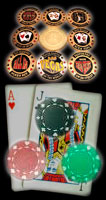
Limp
Calling the blind bet in the pre-flop round of poker betting without raising.
Also called limping into a pot. If this is done as a sandbag, it’s sometimes called a limp-reraise.
Live
Used in the context of either live hand or live one.
Live hand
A live hand is a hand that has not been folded when all bets have been equalized.
Live one
A live one is a player who can be expected to lose chips quickly.
Main pot
If a player goes all-in, the amount of the pot that’s been equalized is set aside as the main pot.
Any further action by other active hands goes into a side pot that the all-in player does not compete for.
Maniac
A wild, very loose, and very aggressive poker player. He plays a lot of hands and almost always raises when he plays. He will frequently raise on a bluff or with a very weak hand.
Morton’s Theorem
A technical result that shows there are certain combinations of pot odds and outs that your opponents can have which create a situation where you don’t profit from a bet if they all call. They all profit from the call, and the largest portion of the profit goes to the best draw.
No-limit
A betting structure where the only limit on bet size is the amount of chips on the table.
Nuts (also nut hand)
The best possible hand. For example, if the board does not contain a pair, and no player has a pair, then an Ace-high hand is the nuts.
Odds
See bet odds, implied odds, and pot odds.
Open-raise
On the first betting round, the first player to voluntarily put money into the pot can do so by either calling the blind or by raising.
A raise by the first player to voluntarily put money in the pot on the first betting round is called an open-raise.
Outs
The number of cards that can be turned up on the next round that will improve your hand to a probable best hand.
Overall
Usually refers to bets and calls as the last action on the river. If there is a bet and a call, the second caller is called an overcall. It generally takes a stronger hand to overcall than to call.
Overpair
A pocket pair higher in rank than the highest card on the board.
Your private two-card hand.
Pocket pair
A pair of cards of the same rank as your private two-card hand.
Position
Your order in the betting sequence. If you are one of the first players to bet, then you’re in an early position. If you’re one of the last players to act, then you’re in a late position.
If there are one or more players who act before you and there are one or more players who will act after you, then you are in a middle position.
Pot odds
The odds the current pot size is giving you to make a call. It is based on the number of bets in the pot, and is the ratio of the number of bets you have to call to equalize the pot and the number of bets in the pot.
Pre-flop
The first betting round. It ’s the betting round after you’ve been dealt your two-card hand, but before the flop is dealt.
Prop player
A proposition player is employed by a cardroom to play. He’s used to start new games or to sit in on short-handed casino games to keep them going for a while.
A prop player plays with his own money and plays in the games he’s assigned, but makes his own choices about how he plays. (See also shill and stake player)
Raise
You raise by putting an extra bet in the pot, requiring other active hands to either equalize the pot by calling your raise or fold.
Rake
Money taken out of the pot by the house dealer. How much is taken is a small fixed percentage of the pot and varies according to the bet limits. Also called the cut. This is the fee the house extracts for covering the overhead associated with the game.



